Note: The panic generator was originally proposed by the author in a project published in a Brazilian Magazine in 1992 and translated into English to be part of one of my books in USA.. Since that time the circuit has been modified and revised to achieve a better performance using new devices that weren”t available at the time of the original writing.
The version is presented here to the reader who wants to make some experiments involving an acoustic phenomenon that is not well known.
Applications:
The interactions between living beings and the sound source represented by the panic generator can be used in many bionic applications, some of them with unknown and unpredictable results. Experiments in this field can be considered very interesting.
How It Works
The operation principle of the panic generator is a phenomenon called beat.
So, to understand its usage, lefs begin by explaíning what beat is.
You may have learned about tuning forks in schoolbooks (see Figure 1).
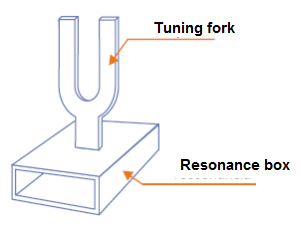
When they are struck, they vibrate at their natural frequency, which is determined by their size, material, and format.
An interesting phenomenon occurs when two tuning forks cut to different frequencies vibrate at the same time and in the same place. If you listen carefully, you not only hear the two basic tones, (for which they are cut) emitted by the forks, but you may hear both a much lower and a much higher tone.
This phenomenon occurs when the two tones are mixed inside your ear, or specifically in the timphanon membrane.
The two additional frequencies heard have the sum and the difference between the original frequencies produced by the tuning forks. If one fork vibrates at 800 Hz and the other at 300 Hz, it is very possible that you could hear a lower-frequency 500 Hz tone (800 - 300) and a higher-frequency 1,100 Hz tone (800 + 300), as suggested in Figure 2.
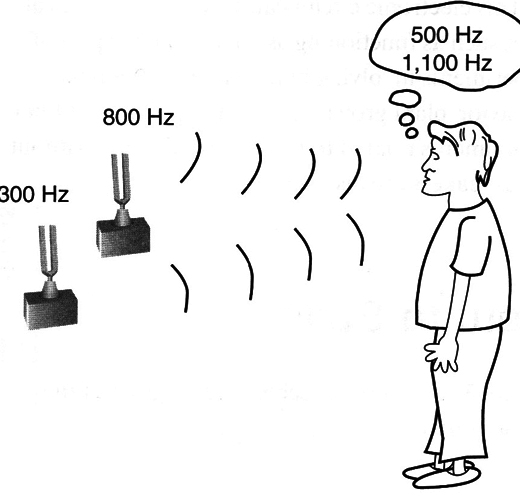
This phenomenon, caused by the interference of the sound waves, is called beat and is also used by electronic circuits with high-frequency signals.
If you examine how the two additional frequencies are produced (1,100 and 500 Hz), you will find that they occur because each point of the eardrum (tympanic membrane) receives, at the same time, vibrations from the two sources. Each part has to vibrate at the same time from the two frequencies.
The movements caused by the two vibrations are combined and, as result of this mixing, two new frequencies are produced.
The important thing to notice in this phenomenon is that the two new frequencies (sum and difference) are not produced by the sound source but in the areas where the vibrations occur. So the two new frequencies take place inside your ear because the eardrum is generating the new vibrations. Thus, the 1,100 and 500 Hz vibrations are produced inside your ear!
Let’s now go a step further and use the same experiments with ultrasonic sources, one of them operating at 19,000 Hz and the other at 20,000 Hz. (Remember that humans can’t hear sounds above 18,000 Hz.)
Of course, nobody can hear the two ultrasounds produced by the sources because they are operating above our hearing limit, but when the two tones are mixed inside the car, they produce two new tones. One of them is the sum tone of 39,000 Hz, which is above the upper limit of our audible frequency range. But the other, the 1,000 Hz difference tone, can be heard, as it is in our audible range.
The interesting fact about this phenomenon is that the different tone is produced inside the ear, or precisely in the eardrum (tympanic membrane), so we have the strange sensation that the sound is generated inside our head or that it comes from nowhere, as shown in Figure 3.

Of course, if the ultrasounds are produced by high-power sources, the audible component generated inside our ear will cause a certain discomfort, and if the exposure to these effects takes place for a long period of time, it can even cause a sensation of panic.
All of these factors are used in our project, which works as follows.
The Circuit
Two ultrasonic oscillators are mounted using two of the four gates in a 4093 complementary metal oxide semiconductor (CMOS) integrated circuit (IC), generating tones in the 20,000 Hz range.
This frequency is chosen because small, common tweeters, such as the ones used in common audio equipment, can reproduce quality frequencies of up to 22,000 Hz.
The two remaining gates of the 4093 are used as low-frequency oscillators, modulating in frequency the high-frequency signals produced by the other oscillators.
The two ultrasonic oscillators’ frequencies change slowly to values under and above 20,000 Hz in a modulation process.
This process has an additional effect on the subjects. The beat changes the frequency, becoming less or more penetrating, like a siren. Because the modulations are not synchronized, the ultrasonic oscillations change their frequencies such that a random beat in the audible range is produced.
The signals of the two modulated oscillators are applied to powerful output stages using power metal-oxide-semiconductor field effect transistors (MOS-FETs). These transistors can source some watts from ultrasounds to small, piezoelectric tweeters, as shown by Figure 4.
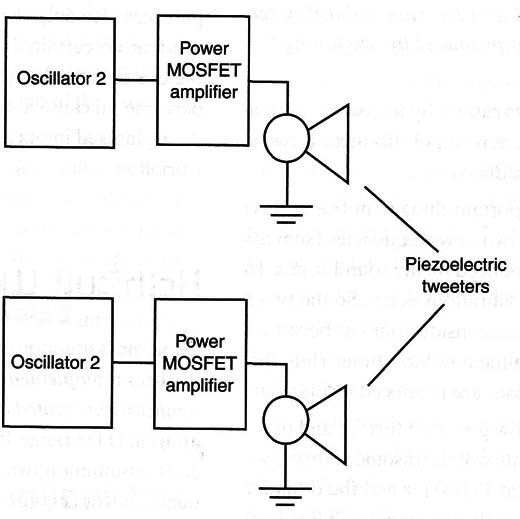
This random beat is in the audible range and, as we explained before, appears inside the ear, causing the strange effect of a deep sound coming from nowhere.
Figure 5 shows the waveshapes in different areas of the electronic circuit and also in the timphanon of a subject experiencing the vibrations produced by the circuit.

This electronic circuit can serve many practical uses, such as functioning as an alarm or as part of experiments involving human behavior, animal behavior, plant growth, and sound pollution. Other experiments related to music reproduction without loudspeakers are also suggested.
How to Build
Figure 6 shows the schematic diagram of the panic generator.

The circuit can be mounted on a printed circuit board (PCB), as shown in Figure 7.
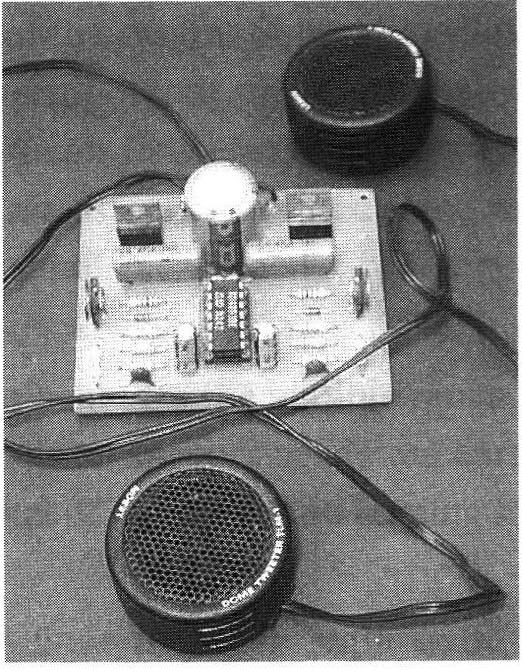
In the figure, the transistors do not appear with their heatsinks, but they are necessary. Any power FET with a drain-source voltage rated to 200 volts or more and a drain current up to 2 amps can be used.
The pattern for the PCB is suggested in Figure 8.

The tweeters are miniature types rated to 80 watts with a frequency response of up to 22,000 Hz or more. The circuit must be powered from a 9- to 12-volt x 3-amp source. A power supply for this circuit is suggested in Figure 9.

The transformer has a primary according to the power supply line voltage (117 VAC, for instance) and a secondary for 7.5 or 12 volts with currents ranging between 3 and 4 amps.
Testing and Using
Place the tweeters 12 to 20 feet from each other. Wire one tweeter to the corresponding output, and turn on the circuit. Next, adjust the corresponding trimpot to cause the ultrasounds to occur (the sounds rise to the treble and disappear).
Then disconnect the tweeter and wire the second one, making the same adjustments. Disconnect the power supply and wire the two tweeters to their outputs.
The effect should result in the sounds being produced inside your ear.
When conducting this experiment, take care not to cause harm to anyone who might be exposed to the sounds. Also, do not use the panic generator during long intervals where people or animals are around.
Improvements and Ideas
The basic version of the panic generator can stand alone as a complete device, but the reader who wants to make further experiments has many options to explore. Some possibilities are given here.
Using External Ampiifiers
If the reader has a good, high-power amplifier, he or she can use it to power the tweeters, which must accept all the power of the amplifier.
It is only necessary that the amplifier have a good response to frequencies in the range between 15 and 25 kHz. Care must be taken not to overload the amplifier’s output with these signals. Figure 10 shows how the external amplifier is connected to the oscillators, canceling the output transistors.
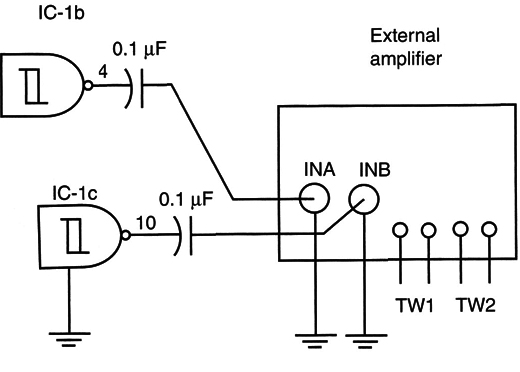
The effects of the beat can be increased if more than two modulated ultrasound sources are used. If three sources are used, for instance, we will have six combinations of beats, with effects that even the author can preview.
Figure 11 shows how two circuits like the ones described in the basic version can source four ultrasonic signals to fill an ambient space.
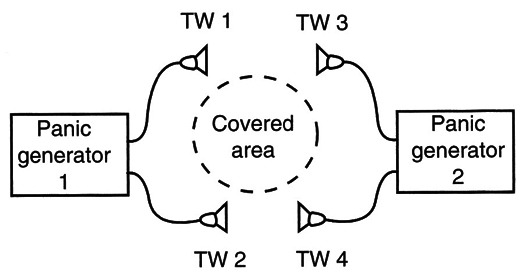
A Circuit Using the 555 IC
Another circuit of a panic generator can be built using the famous 555 1C, as shown in Figure 12.

Four 555 ICs are used as astable multivibrators in this configuration. Two of them generate the high-frequency tones, applying them to powerful output transistors.
Power MOSFETs are also mounted on heatsinks, and the frequency of these oscillators are adjusted by trimpots.
The other two 5555 generate the modulation signals and are adjusted by the correspondent signals. The performance is the same as the basic version.
P3 and P4 adjust the amplitude of the modulation. Small changes in the components’ values could be necessary to compensate for their tolerances and achieve the best performance.
Using Darlington Transistors
Power NPN Darlington transistors can be used, replacing the power MOSFETS. Figure 13 shows how to make this replacement.
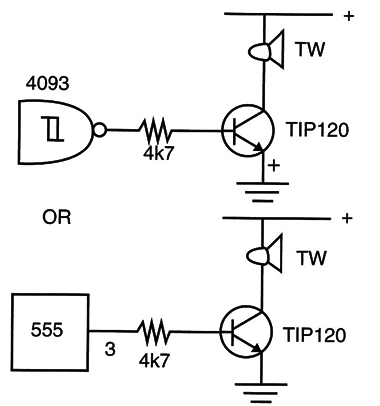
No change is necessary in the PCB and in the basic circuit. Types such as the TIP120, TIP121, and TIP122 are suitable for this project. They also need to be mounted on heatsinks.
More Ideas and Experiments
The effects of combining beat and ultrasounds are not well known within the science field. Recently, a program was shown on the Discovery Channel where the effects of many types of sounds, including low frequencies, were discussed.
They didn’t report anything especially dangerous or that any special effect affected internal organs, but we recommend care when working in this area.
Experiments have shown that exposure to ultra-sounds and infrasounds (sounds below the audible limit or below 16 Hz) for long time intervals can cause digestive problems such as nausea and dysentery.
We strongly recommend again to the reader to take care during experiments involving this circuit for long periods of time. Turn your device off if you feel something wrong with your stomach or intestines.
The author wrote some years ago an interesting comic story involving a mad professor who developed a powerful ultrasonic generator modulated by low frequencies (infrasounds) such as the one described here.
Professor Ventura (Soon in the site) used it to scare birds from a particular square in his city.
The birds were perched in the trees and anyone who tried to walk under them felt a splash on the head.
The professor was able to use his device to scare the birds away, but the side effect of the circuit was not anticipated by Professor Ventura: dysentery.
After the mayor announced that the square was free from the birds, the effect exploded like a bomb: Any of the citizens who spent some time in the square left in a panic with a terrible dysentery crisis.
This idea was explored on the Discovered Channel where some documentary filmmakers tried to reproduce these effects using low-frequency, powerful amplifiers. Although the story exaggerates the supersound effects, we suggest that the reader try not to repeat this experience.
However, we’d like to present some ideas for some bionics experiments using your panic generator with friends and other living beings:
Alter C2 and C6 to have a different modulation pattern.
Use this circuit as part of an alarm, and control the power supply via a relay.
Place the circuit in a location where you could attract the attention of people or animals.
Expose volunteers to this circuit during time intervals between 10 and 15 minutes (but no more to prevent causing a panic). After the session, test the people’s skill in some activities. The reader could determine how sonorous pollution can affect human reactions, such as causing stress.
You can also use this circuit as an alternating method of pest control on farms. Investigate how can birds or insects can be affected by the vibrations produced by the panic generator. Be sure to keep domestic animals away from the device as exposure to the vibrations could be harmful.
Experiments in growing plants and germination can also be conduced using the panic generator. Select two groups of fast-growing plants, such as bean plants, and measure the rate of growth of each group: the one exposed to the panic circuit vibrations and the other that isn’t. Then compare the growth. In an experiment involving the effect of magnetic fields on plant growth or germination, you can use coils instead of tweeters and apply the signals to the plants. The coils can be made by wiring 30 to 50 turns of common wire around cardboard squares (15 X 15 cm).
- Another possibility for this circuit is determining how ultrasounds can affect organic processes or interact with them. You can perform experiments with plant growth to see how noise and sounds affect common plants such as tomatoes and beans.
An Idea to Explore: A New Sound-Reproducing System
You can use a new form of sound reproduction using the beat. as proposed by the author in 1992, where the sounds are generated inside the listener‘s ear without the need for loudspeakers or earphones.
Two oscillators coupled to powerful ultrasonic transducers will be used. One of them operates in a fixed frequency and the other in the same frequency but modulated by a sound processor circuit, such as an audio Amplifier.
The beat resulting from the two super-sound signals inside the listener‘s ear will reproduce the sound applied to the audio amplifier, such as the sound from a CD player, microphone or other source. as suggested in Figure 14.
Make sure that the listener will hear the sounds inside his or her head as the beat is produced in the timphanon membrane, he or she will have the strange sensation that the sound comes from nowhere.
An American laboratory is now working with a commercial sound reproduction system using this effect which is not quite so new as they claim. (The article was written in 1992)
The difficulty in developing this circuit is that the beat should correspond in frequency and intensity to the original sound and a simple direct modulation not enough for that.
The signal to modulate the ultrasonic sound needs complex processing that would require some research. It is a Very interesting subject to be explored by the reader who likes advanced work in bionics, electronics, and acoustics.
Figure 14 – Brontophonic – a new idea of sound reproduction proposed by the author
Brontophonic comes from brontus a Latin word meaning thunder. This describes a kind of sound that produces the low frequencies that cause other vibrations in a higher frequency to occur, such as thunder vibrating a window. This can also occur when a heavy truck passes by in the street.
Circuit 1 – Fig. 8
IC1: 4093 CMOS integrated circuit
Q1, Q2: IRF630, IRF620, or equivalent power FET (see text)
D1, D2: 1N4148 general-purpose silicon diodes
R1, R7: 330 k Ω, 1/4-watt, 5% resistors, orange, orange, yellow
R2, R8: 47 k Ω, 1/4-watt, 5% resistors, yellow, violet, orange
R3, R4, R9, R10: 22 k Ω, l/4-watt, 5% resistors, red, red, orange
R5, R11: 4.7 k Ω, 1/4-watt, 5% resistors, yellow, violet, red
R6, R12: -10 k Ω, 1/4- watt, 5% resistors, brown, black, orange
P1, P2: -100 k Ω- trimmer potentiometers or common potentiometers
C1, C5: -0.22 µF ceramic or metal film capacitors
C2, C6: - 10 µF/12V working voltage DC (WVDC) electrolytic film capacitor
C3, C7: 2,200 pF ceramic or metal film capacitor
C4: 1,000 nF/12 WVDC electrolytic capacitor
TW1, TW2: 4 or 8 Ω mini-piezoelectric tweeters to 80 watts or more
Other parts: PCB or solderless board, wires, power supply (see text), heatsinks for the transistors, plastic box, etc.
Circuit II – Fig. 12
IC-1 to IC-4: 555 integrated circuits
Q1 and Q2: IRF63O or any equivalent-power MOS-FETs
R1, R2, R3, R4: 22 k Ω x 1/8 W resistors, red, red, orange
R5, R6: 2.2 k Ω x 1/8 W resistor, red, red, red
R7, R8, R9, R10: 4.7 k Ω x 1/8 W resistors, yellow, violet, red
R11, R12:1k2 Ω x 1/8 W resistors, brown, red, red
P1, P2, P3, P4, P5, P6: 100 kn x 1/8 W trimpots
C1, C2: 0.047 µF ceramic or polyester capacitors
C3, C4: 2.200 pF ceramic or polyester capacitors
C5: 470 µF x 16 V electrolytic capacitor
TWI, TWZ: 4 or 8 Ω mini-piezoelectric tweeters to 80 watts or more
Other parts: PCB or solderless board, wires, power supply (See text), heatsinks for the transistors, plastic box, etc.




